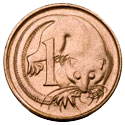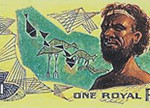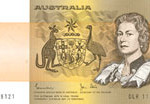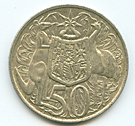 You’ve probably got some on your person right now, either in the wallet or purse or just shoved into your pockets. But there’s more to know about money than just how to make it, spend it, save it and try to not pay too much tax on it.
You’ve probably got some on your person right now, either in the wallet or purse or just shoved into your pockets. But there’s more to know about money than just how to make it, spend it, save it and try to not pay too much tax on it.
Alex Wilson, writing for savingsguide.com.au, researched some of the lesser known and tantalising facts about Australian money — you may or may not know some of these gems of information, but you can file the following away to either one day start a conversation at a barbecue or bore the kids.
Do you remember the 1 and 2 cent coins?
Some readers may not even remember the 1 cent coin (there’s one pictured above), but we’re sure many others will recall the “copper” 1s and 2s with either nostalgia or a feeling of “good riddance”.
They were actually made of bronze and filled Australians’ change pockets before they were withdrawn from circulation in 1992. Once collected, most the coins were melted down and the metal re-used. All of the bronze medals awarded in the Sydney Olympics of 2000 were made of recycled 1 and 2 cent coins.
We developed the world’s first plastic bank note
Due to paper money forever needing to be replaced due to wear and tear, Australia was the first country to pioneer plastic, or polymer, money. In fact my cousin Neil Burnham was centrally involved in the polymer note technology and adoption while working at the Note Printing Australia, which is owned by the Reserve Bank. Many other countries have since adopted using polymer bank notes for their currency.
The polymer notes can stay in currency four times longer than their paper counterparts. Pair this with the fact they are harder to counterfeit, our polymer invention seems to be the future of printed money — although countries such as the US seem to be welded on to paper bank notes (and they even retain their 1 cent coin).
Plastic notes even withstand going through the washing machine, which has been a notorious unintended way to destroy good money in the past. As the notes are made of plastic, people often wonder whether they are capable of withstanding the heat of an iron — the answer is yes, though only at a mild temperature. As with any plastic, it definitely has a melting point, which Wilson points out is sure fire way to burn through your money (pun intended).
A little “folding money” history
Note Printing Australia began life in 1912, releasing the first Australian Commonwealth bank note in 1913 (so celebrating 100 years of operation this year). Originally reporting to Treasury, it was set up in King’s Warehouse in Melbourne (then Australia’s capital), which still stands and is now owned by Lindsay Fox and used for his car museum.
In 1924, Note Printing moved to Fitzroy and reported to the newly formed Commonwealth Bank. When the Reserve Bank was formed in 1960, the note issuing function moved under its auspices. In 1981 a new plant was set up in Craigieburn.
Australia nearly had a currency called “royals”
 In 1965, Sir Robert Menzies was the prime minister and Australia was in the process of switching from pounds, shillings and pence to its own national currency. Menzies suggested the new currency be called “royals” — further showing his monarchist loyalties (an early design is shown here).
In 1965, Sir Robert Menzies was the prime minister and Australia was in the process of switching from pounds, shillings and pence to its own national currency. Menzies suggested the new currency be called “royals” — further showing his monarchist loyalties (an early design is shown here).
 The name was trialled for a while, but eventually “dollar” was agreed upon, although Wilson says it was not after some other hysterical suggestions, including: the oz, the roo, the austral, the digger, the emu, the boomer, the kanga, the kwid, the dinkum and even the ming (Menzies’s nickname).
The name was trialled for a while, but eventually “dollar” was agreed upon, although Wilson says it was not after some other hysterical suggestions, including: the oz, the roo, the austral, the digger, the emu, the boomer, the kanga, the kwid, the dinkum and even the ming (Menzies’s nickname).
You can even invest in actual money
The Australian mint often produces “limited edition” coins and banknotes that are legal tender, like the rare $5 coin. This means that while the coin may be worth $5 exactly in a retail sense, due to their scarcity investors pay more for the coin itself as a collector’s item. This means they invest much more for a note or coin than it actually has as a legal value, in the hope that time will see said value appreciate.
 The 50 cent coin, introduced in 1966 with all the other decimal currency, used to be a round shape (not 12 sided as it is now) and was originally made with 80% silver (see picture). But as the value of silver increased, the 50 cent coin’s bullion value became more valuable than its actual face value, so they were withdrawn from circulation a short time later and replaced with the coin we use today (which is made of a copper-nickel alloy, also known as monel).
The 50 cent coin, introduced in 1966 with all the other decimal currency, used to be a round shape (not 12 sided as it is now) and was originally made with 80% silver (see picture). But as the value of silver increased, the 50 cent coin’s bullion value became more valuable than its actual face value, so they were withdrawn from circulation a short time later and replaced with the coin we use today (which is made of a copper-nickel alloy, also known as monel).
Fake $50 notes have been successfully made
Polymer plastic notes are reputed as near impossible to counterfeit, however some crafty crooks out there have still managed to copy the $50 note, making it the most frequently copied banknote. Police have managed to shut down most of these illegal operations and clamp down on these illegitimate notes.
There are however some slight design variances between $50 notes (such as some having names printed under the portraits used on the note, which were added in 2002), but these are still legitimate.
To spot a “real” fake fiddy, as it were, the Federal Police advise that the stars of the Southern Cross found on the note’s translucent window can be scratched off with a fingernail or coin. The real notes have stars that are unable to be removed as they are covered with a very durable coating.
Other security measures found on Australian bank notes include; micro printing, raised ink (you can actually feel the texture on the note), fluorescent ink (Wilson says you can see the denomination numeral on $20, $50 and $100 notes along with a square shape on $5 notes) and more. You simply need an ultraviolet light to view these.
It’s a crime to damage money
The costs of producing our money are funded by the government and in turn are the property of the government. Any intent to willfully deface, disfigure, mutilate or destroy any coin or note is technically punishable by law and carries a fine of up to $10,000 or two years in prison (Wilson warns those ironing notes [see above] to watch out).
Money is not that dirty
An urban myth that has been doing the rounds for years is that money is crawling with germs. However research conducted at the University of Ballarat indicates that coins and bank notes, while indeed carrying some levels of bacteria, do not do so on a scale that is seen as overwhelming or deadly. Like on any object, germs are present (surprisingly salmonella is not uncommon) although still did not pose a concern to the researchers.
The change to decimal
There may be some readers who remember the move from pounds, shillings and pence to the decimal currency on St Valentine’s Day in 1966. So here’s an old TV ad from the time (it’s four minutes long), just to take you down memory lane.
